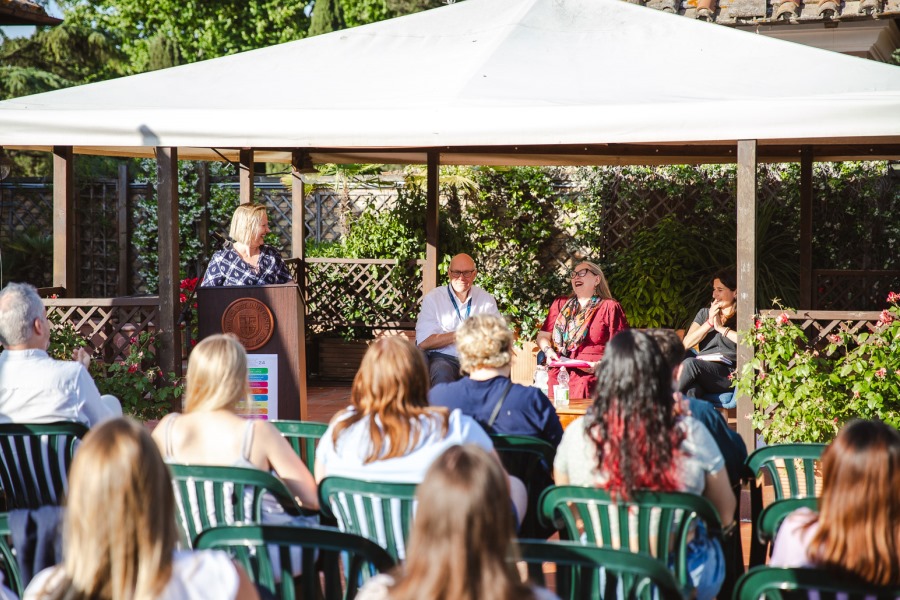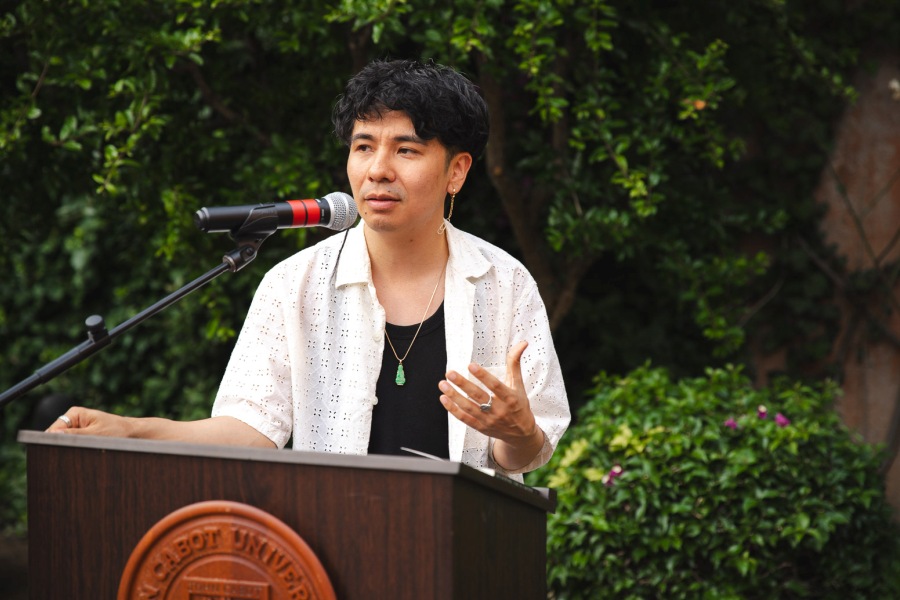Autumn in Venice: Professor and Author Andrea di Robilant
Creative Non-fiction and Travel Writing Professor Andrea di Robilant describes his transatlantic upbringing, compelling journalism career, and names five must-reads for aspiring travel writers. In addition, Professor Di Robilant also gives a glimpse into his latest, Hemingway-themed, authorial venture, Autumn in Venice, published last spring by Knopf.
 What was it like to grow up with an Italian father and an American mother?
What was it like to grow up with an Italian father and an American mother?
Ah! You should talk to my shrink! … It obviously gave me a richer background – to be familiar with two cultures, to have two languages, to be able to move from one to the other in a fairly seamless way… But when you are growing up, when you are trying to forge an identity of your own it can pose some problems. It certainly did in my case. I lived in the US for many years and thought myself American and put a certain distance between myself and my Italian roots in a forced, unnatural way. For example, for years I rarely read books in Italian. It is only with time that I was able to bring my two halves closer together – convivere is the Italian word. It’s a long, slow process.
Your travels have taken you to many different places across the globe. What country has fascinated you the most and why?
Iran no doubt. Not so much a country as a civilization. I went right after high school in 1975. I remember traveling cross-country and being mesmerized by the layers of history, the extraordinary architecture, the landscape, the language (I later studied Farsi at Columbia University) and yes, even the food. Eventually, I took a job as a teacher at the State University in Tehran. The Revolution was four years away but the cracks were evident.
What did you like most about being a journalist?
It is a profession that gives instant gratification, very libidinous in a way. You have an intuition, a sudden urge to pursue it, to figure things out. So you find the right people to talk to. And then it’s done, and you move on to the next thing. The joy of seeing the flicker of a story, chasing it, piecing it together for others to enjoy – one is on a sort of high during the whole process. And that’s true whether you are doing a major piece of investigative writing or putting together a whimsical little neighborhood story.
What made you decide to leave journalism to become a full-time writer?
One never really leaves journalism. The urge is always there. But daily journalism can be a grind. It leaves little time for anything else. There were books I wanted to write, and then teaching came along and it turned out to be very enjoyable and rewarding. Meanwhile, traditional print newspapers were in decline. The newsroom was not fun anymore. It was time to move on. But I still think like a journalist, even when I’m writing biographies or history books. Now and then someone will say something and I will say to myself: “Damn … that would be a good story to write.” And sometimes I do write it for some magazine or other. And it’s like giving myself a little treat.
What was the biggest challenge you have faced in your career?
As a journalist, the biggest challenge was covering Italian politics after years of being a foreign correspondent. As an author I suppose that writing a book about Ernest Hemingway, about whom so much had already been written, was something of a challenge. I was constantly worried about the literary firing squads ready to open fire. Teaching is really about sustaining a conversation – especially in courses like the ones I teach. As in all conversations, the biggest challenge is to avoid reacting defensively to criticism.
How did you get the idea to write Autumn in Venice?
I am not a Hemingway scholar and I wasn’t even a particular fan of his. But one day I met a man who told me that he had sold the last batch of letters Hemingway had written to his friend’s sister, an attractive young Venetian woman, to the JFK Library. I thought there might be an interesting story there so I pursued it, and eventually, it led to Autumn in Venice.
Did you write the book in Italian and translate it yourself into English? What challenges did this present?
I wrote the book in English because my main publisher is American. It wouldn’t do to hand in a manuscript in Italian! Then I translated and rewrote it into bad Italian. My wife Alessandra helped me put it into good, readable, Italian. Translating oneself is much more difficult than one thinks. You tend to put the automatic pilot on. There is no creative process. You think you are doing a fine job but the prose is lifeless. And the funny thing is you don’t realize how bad it is – until someone tells you. So I wouldn’t be able to do it without Alessandra. But otherwise, I’m equally at home in English and Italian. My career in journalism was mostly in Italian. But I wrote all of my books in English.
Autumn in Venice is described as “the remarkable story of Hemingway’s love affair with both the city of Venice and the muse he found there – a vivacious eighteen-year-old who inspired the man thirty years her senior to complete his great final work.” Given that Venice is the backdrop of many of your works, could it be said that the city is your muse as well?
It certainly has been a source of inspiration. The city, its archives, just brim with good stories. But Venice the muse has inspired me for nearly twenty years now, and I think we’re both feeling the wear and tear. It’s probably time to move on. But not before I write one more book on Venice and the Renaissance.
What is the most important thing that you teach your students in your Creative Non-fiction and Travel Writing courses at JCU?
Be alert to one’s surroundings, observe, engage. Everywhere we look there are loose narrative threads that are lying dormant. The trick is to ‘see’ them and pull at them and bring them to life until they become a full-fledged story. Sometimes my students come to class and tell me they have no ideas, nothing to write about. We go over the seemingly banal incidents of everyday life, and it’s always richer than we first imagine.
Name five books that everyone should read.
Well, I’ll limit myself to five essential books for all aspiring travel writers: Italian Journey, because Goethe is the father and mother of travel writing; Etruscan Places, because D.H. Lawrence brought modernism to travel writing; Robert Byron’s The Road to Oxiana, because it was the favorite book of my favorite 20th century travel writers; Norman Lewis’s Naples ’44 because of the sheer beauty of the prose and Joseph Brodsky’s Watermark – travel writing that is also sublime poetry.
Read the reviews of Autumn in Venice
The Times: Autumn in Venice: Ernest Hemingway and His Last Muse by Andrea di Robilant — the gripping saga of the writer’s final fling
The Washington Post: The Venetian teenager who stirred Hemingway’s heart and art





